How To Save Money on Sewing Supplies
Having a hobby is usually a good thing and sewing is no exception. From the feeling you get walking down the street in something you made yourself, to the strong possibility that it might even help to protect your brain against long term health conditions, sewing is a wonderful thing.
Unfortunately, it can be expensive. Cotton fabric alone costs anything from about £6 to £16 a metre. Patterns often cost about £10 each. Then there are the other things you need to buy: buttons, zips, snaps, bias binding, lace trim, bag handles, it all adds up. And this is assuming that you already have a sewing machine!
So how can you still indulge in the hobby you love without spending money that you just don’t have?
Here are 11 tips to help save money on sewing supplies.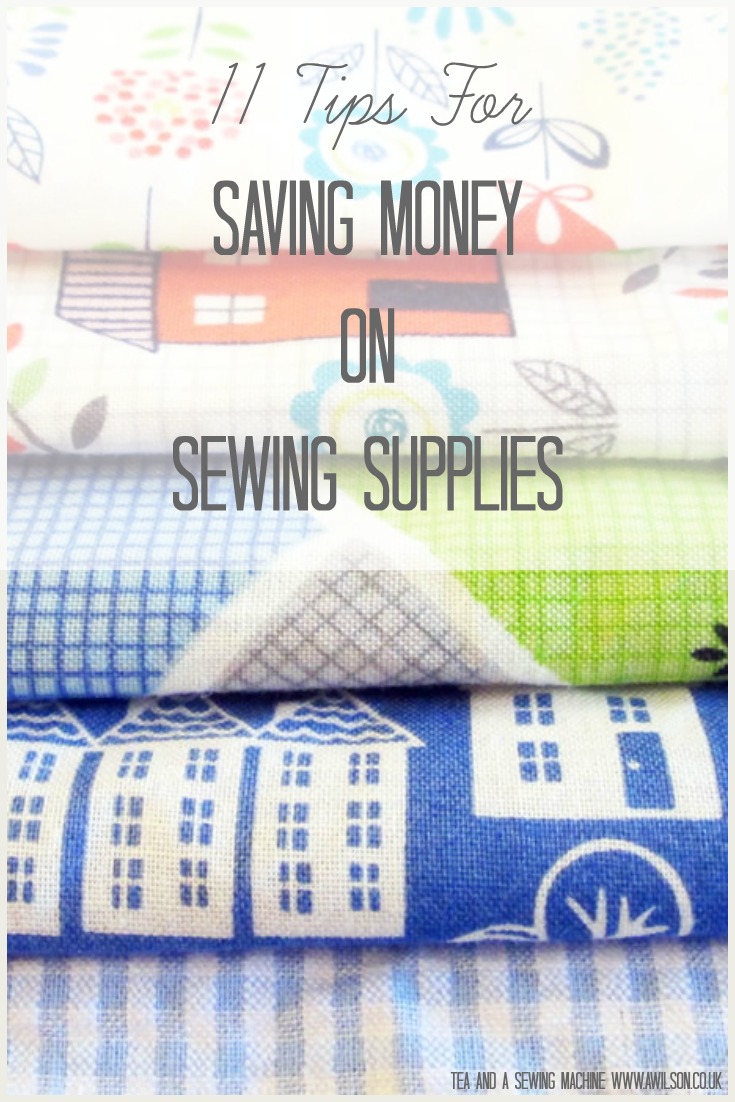
11 Tips to Save Money on Sewing Supplies
Use what you have.
One of the easiest areas to save money on sewing supplies is fabric.
If you are making something small like a bag or a purse, or something for a child, you might already have something that you could use. If you have been crafting for a while, you will probably have accumulated quite a hoard. It’s easy to forget what you have, especially if your organisation system is like mine!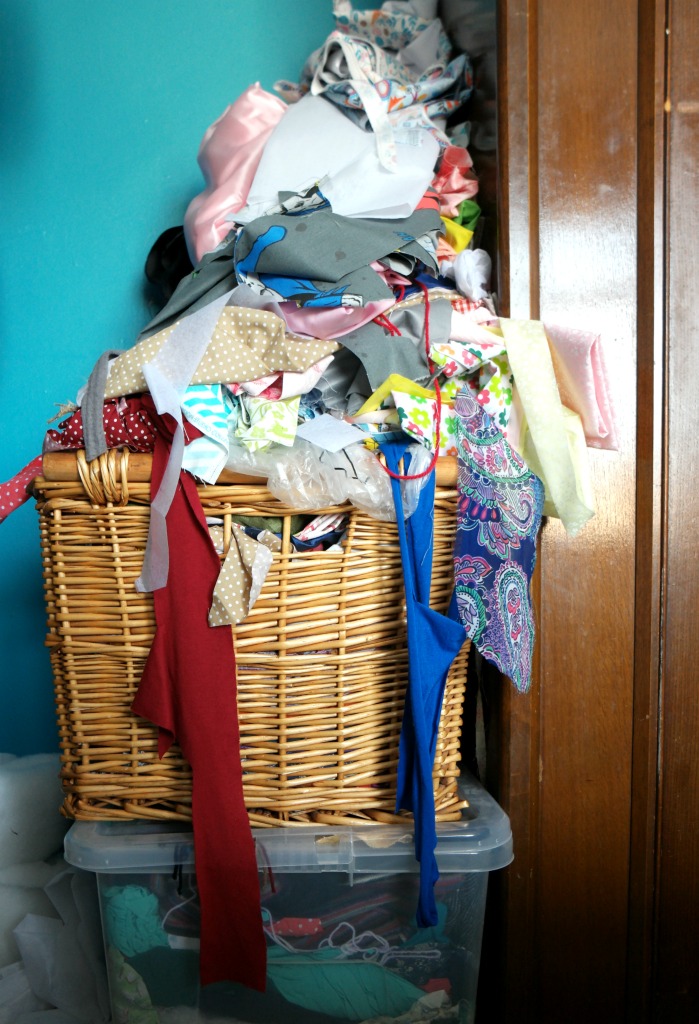
Horrors. Anyway.
By having a rummage, you will probably unearth all sorts of treasures that you’d forgotten you had.Some of it might be tiny scraps, but if you’re anything like me, there’ll probably be some bigger bits as well. You might have made something a while ago and overestimated how much fabric you needed and ended up with a lot left over. Or you bought something with an idea of what you would use it for, but never got around to it. Or maybe you bought a fat quarter bundle and only used some of it. It’s probably worth a look!
Look For Other Sources of Fabric
Fabric doesn’t just come of a roll in a shop! There are all kinds of other places where usable fabric can be found.
There is a lot of fabric in a man’s shirt, especially if it’s a shirt belonging to a large man. I made these toddler trousers for Cosmo a couple of years ago out of one of Husband’s old shirts and they didn’t cost a penny!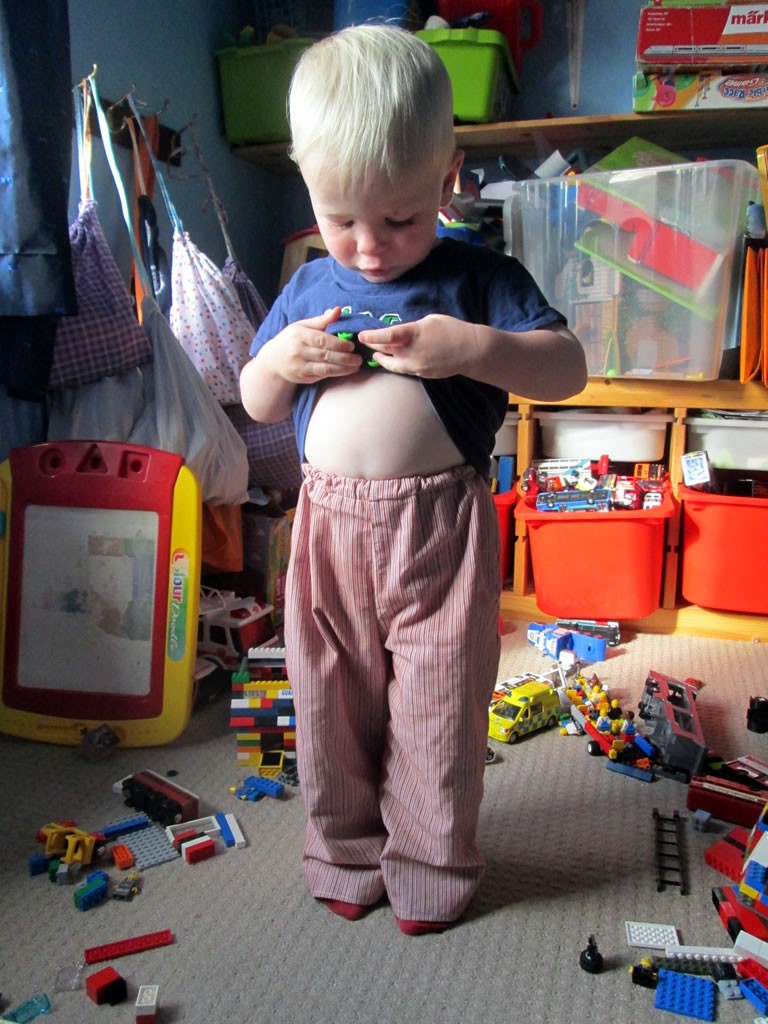
Old duvets, pillowcases and tablecloths are a good source of fabric. You could also look in your own wardrobe and upcycle clothes you don’t wear any more into something new.
Raid the Charity Shops
If you don’t have a ready supply of shirts and old duvet covers, charity shops are a good place to look. Junk shops also sometimes have things you could use. I picked up these possibly Liberty table cloths from a junk shop a couple of years ago for 50p each! Although they are worn at the edges, the fabric in the middle is still usable.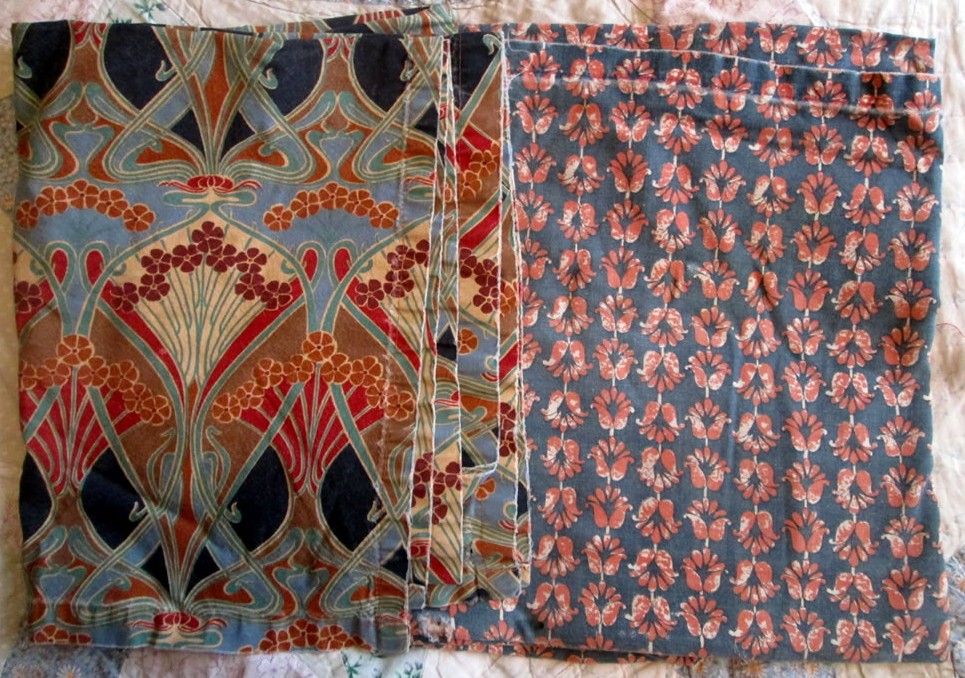
Repurpose Unfinished Projects
You might have some good stuff lying around in the form of projects you’ve started but for whatever reason haven’t finished. Be honest with yourself. Are you going to finish it? Yes? Great. No? Unpick it, unravel it, take it apart. You’ve just gained some more craft stuff!
Use the Expensive Stuff Sparingly
Lots of the quilting cottons are gorgeous. But much as I would love to, I would never make an entire dress out of Amy Butler fabrics. It would cost a fortune! So a compromise would be to use the expensive stuff for collars, pockets, frills, edging, contrast bands, cuffs etc and to use cheaper fabric for the main body of the thing.
Buy What You Need
It can be tempting to buy an extra couple of metres of something “just in case”! Even if you don’t do this, if you don’t need a whole metre, try to buy small amounts. My local fabric shop sells quilting cottons by the quarter metre. Some places will let you buy a swatch (or send you one for free!), which is great if you only need a tiny bit, for example for some applique.
If you do only need a very small amount and you can only buy it buy the metre, consider whether you have anything else you could use instead.
Look Out For Sales
Lots of places have end of season sales and other places will often have remnants for sale. If you follow fabric shops on Facebook, they will usually announce when they have a sale on.
Sometimes markets are a good place to get fabric cheaper.
See what you can get for free
I have added to my button jar by collecting spare buttons normally included when you buy a top or a cardigan.
If you have friends and family who are chucking out old curtains, duvets or tablecloths (or anything else that might be useful!) ask if they will let you have it instead.
Make Small Things
A tiny little purse uses much less fabric than a huge, swirly, full length dress with several layers of net petticoat, and so is much cheaper to make. If patchwork is your thing, making cushions or bags will be cheaper than making full sized quilts. You’re also more likely to have enough fabric already from left over projects, so you might have a scrap of something lovely you can use without having to buy more.
Make Stuff to Sell
A word of warning first! This can be harder to do than people would sometimes have you think.
2 options are Etsy and Ebay, but selling via these sites can be difficult.
Etsy is huge. Unless you have a distinctive style and probably some skills in internet selling, it can be very easy for your little shop to get lost among the thousands of others.
Ebay presents a different set of problems, one of them being that a lot of people on there just want stuff for nothing. It’s probably not be the best place to sell beautiful handmade things that took hours to make!
However there are people who successfully sell their handmade things in this way.
(If you’re interested, I have a shop on Etsy that sells PDF patterns, craft kits and handmade bits and pieces!)
Also, if you have a ready supply of family and friends who admire your stuff, you might find that you have some willing customers there! If this is the case, you could extend it by selling via Facebook.
Make Stuff to Give Away as Presents.
If you normally spend £20 on a birthday or Christmas present for somebody, spend it on crafting stuff and make them something instead!
Use Patterns More Than Once
Patterns can be expensive, but if you make several things from one pattern, it spreads the cost out. Don’t worry about having things that all look the same. It’s surprising how different something can look if you just use different fabric. You could also consider how else the pattern could be modified or what else you could do to make something different. You could change the length, add patch pockets or change the neckline.
Use Free Patterns
Better still than buying a pattern, use a free one! There are lots out there, and lots of free tutorials as well.
Learn to Make Stuff Without a Pattern
Simple projects can often be made without a pattern. A good place to start is a circle skirt. If you sign up for my emails (the form’s at the side and at the bottom), you’ll get emailed a tutorial and a place to record your measurements.
An if you like the circle skirt tutorial, you might also like my ebook, Sewing Clothes Without a Pattern: 6 Projects to Kickstart Your Handmade Wardrobe!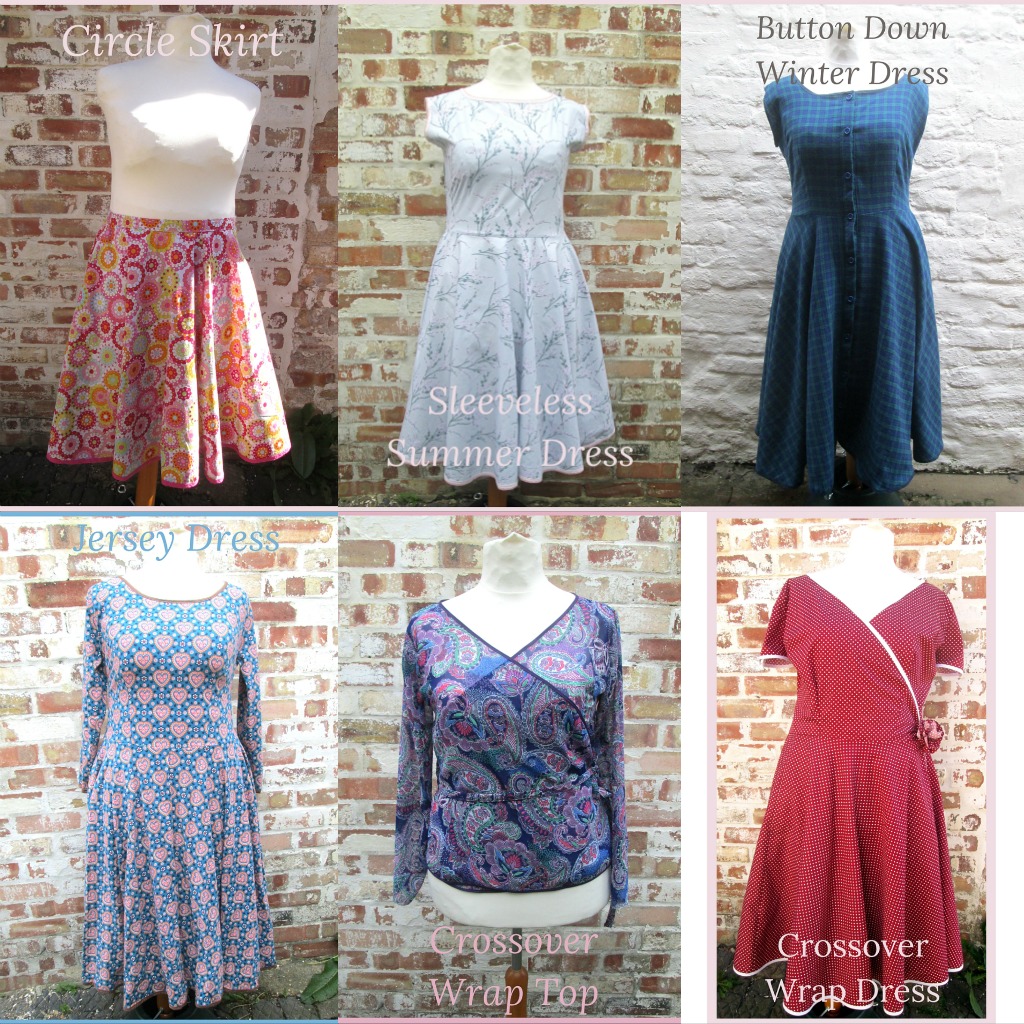
Do you have any tips to add? Leave them in the comments below!


Anna, I love your blog! I’m new to your site but I’m going to enjoy checking out all the links you’ve supplied, just for a read. You are absolutely right, fabric can be so expensive but my biggest problem is the added cost of postage. I live in the Highlands, but not outer remote, but not within 80 miles or so of a fabric shop either, so everything has to be bought online. Some companies even try to charge you more for postage just because I’m in Scotland! I’m afraid they don’t get my business! Ok, I’ve had my moan. Time to get sewing!
We have 3 cities all about 40 miles in different directions! Our nearest town is 6 miles away and it has a fabric shop but it’s awful, so I get a lot of stuff online. Nobody tries to charge extra for postage though :/
Thanks for the money saving tips, I found them very helpful. Our summer is on its way and I added lace trimming to a few of my older tops, it makes it look quite different than before.
Regards
Magda from Pretoria, South Africa
That’s a good idea 🙂
Hello from still sunny Suffolk!
I’m fairly new to the dark art of quilting, but have been sewing from before I could reach the treadle on my grandma’s old black and gold Singer!
Since learning to quilt this year, I’ve accumulated a vast stash of yardage, fat quarters, and an even more vast stash of scraps. I’ve made a conscious decision not to throw them out, so had to organise myself with the use of plastic shoe boxes.
As soon as I finish a project, I sort the scraps into colours, and then cut anything of reasonable size into 6″, 5″, 2.5″, or 1″ squares ready for a wet afternoon or whenever the urge to create strikes…
I too have opened a etsy shop – so far with no positive results, but I live in hope.
That’s really organised! I should start some kind of system. That mountain of fabric in the photo has spawned a couple of other mini mountains on the other side of the room. I’ll have difficulty getting into bed before I know it!
I’ve recently discovered some tricks to getting more traffic to my etsy shop. Email me if you like and we can chat some more 🙂
Hi Anna, nice to meet you. Dare I say it’s lovely to meet someone living in England. So many things I have found I realise are based in the States. Anyway, I have just retired and want to restart my limited sewing ability I learnt as a child. I have collected most of my things, have scoured charity shops for material and have found some lovely things, I have got books and ideas…but then it stops. I have decided my real hobby is collecting all these things, piling them up, looking at them but doing nothing with it! I want to, I really do but where do you get the get up and go and the right I must stat now from. With love from Sue
I was the same when I started blogging! I read loads of books, other blogs, pinned stuff, chose colour palettes.. in the end I just had to put the books down and do it! My advice would be to choose something easy that won’t take too long and just go for it:)